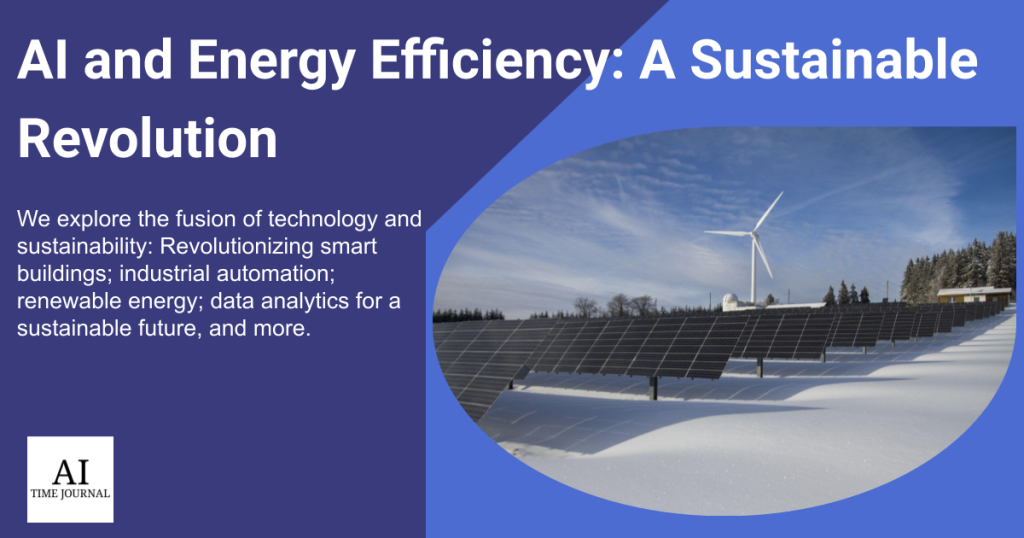
We are living in a time defined by an urgent need for sustainability, the fusion of artificial intelligence AI, and energy efficiency. As the world grapples with the growing challenges of climate change and resource depletion, the integration of AI-driven solutions into energy management represents a sustainable revolution of great importance. AI has the power to speed up decision-making, automate operations, and optimize processes by utilizing cutting-edge algorithms, machine learning, and data analytics. The ability of AI to analyze big datasets, forecast outcomes, and adjust to changing conditions is altering a range of industries, from manufacturing and healthcare to finance and transportation.
We will take a look at the importance of AI and energy efficiency, unveiling the innovative technologies and strategies reshaping the landscape of sustainable energy practices. AI is poised to change the way we produce, distribute, and consume energy, offering a promising path toward a greener, more sustainable future. AI is a gift that has many benefits, especially in our case to have a more sustainable future. As the founding CEO of the Allen Institute for Artificial Intelligence Oren Etzioni once said “AI is a tool. The choice about how it gets deployed is ours.”
Table of Contents
- AI in Smart Buildings
- AI in Industrial Automation
- AI in Renewable Energy
- AI in Transportation
- AI in Energy Data Analytics
- Challenges and Solutions
- Ethics and Environment
- Conclusion
AI in Smart Buildings
First, let’s talk about the AI’s ability to optimize energy in smart buildings. AI’s presence in smart buildings is revolutionizing the way we design, construct, and manage modern structures. Through the integration of artificial intelligence (as well as IoT devices, & advanced data analytics) smart buildings can optimize energy consumption, enhance security, improve occupant comfort, and even cut down their operational costs. What these AI-driven systems can do is learn and adapt to the occupants’ preferences, making buildings more responsive and efficient.
This leads us to how AI caters to an occupant’s comfort conserving energy all while saving the occupants money. AI-controlled devices can tailor lighting, heating, and cooling based on user preferences and behavior. This enhances comfort while cutting down on wasted energy. This is also becoming a trend used in the hotel industry where AI is used to forecast guest preferences through data analysis and predictive modeling.
AI optimizes heating, cooling, and lighting systems based on real-time data, occupancy patterns, and weather forecasts. This leads to reduced energy consumption, lower utility bills, and substantial long-term energy cost savings. Another great way AI helps increase savings is through water conservation. AI monitors water consumption and detects leaks promptly. This will reduce water bills and prevent costly water damage to the building.
AI in Industrial Automation
Industrial automation refers to the use of technology, control systems, and machinery to perform various tasks and processes with minimal human intervention. This can be seen in industrial settings like manufacturing, production, and logistics. Boosting Efficiency in Industrial Processes Enhancing productivity, quality, safety, and efficiency in industrial operations are the main goals of industrial automation.
Here are some examples of how industrial automation takes place in their industrial setting:
- In manufacturing AI-driven robots and cobots (collaborative robots) perform a wide range of tasks. They can first assist in assembly and material handling. All the way to complex precision work, increasing production speed and consistency.
- In production, AI algorithms will manage production schedules based on changes in demand, the availability of resources, and other determining factors, which results in shorter lead times and better resource efficiency.
- In logistics, from demand forecasting to inventory management, AI helps optimize supply chain logistics, ensuring that supplies and goods are available when needed while reducing costs.
Applying artificial intelligence (AI) and machine learning (ML) techniques, predictive maintenance tries to predict when machinery or equipment is likely to break down so that maintenance can be carried out just in time. Compared to traditional reactive or planned maintenance, this proactive approach to maintenance has a number of benefits, including lower costs, less downtime, and increased operational effectiveness. Predictive maintenance depends on data from various sources, which include sensors, IoT devices, and equipment logs. These sources are continuously collecting information on equipment performance, operating conditions, and environmental factors to make their decisions.
AI in Renewable Energy
Energy that comes from naturally existing sources is referred to as renewable energy. Since they are continuously renewed by natural processes, these sources are regarded as renewable because they provide a long-term and sustainable source of energy. Managing renewable sources with AI refers to the use of AI techniques to optimize the generation, distribution, and utilization of renewable energy sources. Solar, wind, hydro, and geothermal power are all examples of these energy sources. This involves applying AI algorithms, data analytics, and automation to improve the efficiency, reliability, and sustainability of renewable energy systems.
In order to maximize the efficiency, dependability, and overall performance of solar and wind power generation systems, AI uses a variety of strategies and technologies. Renewable energy sources like solar and wind power have grown in significance as we move toward a cleaner, more sustainable energy future. The supply of renewable energy can be made more reliable and affordable by optimizing these sources. For example, the use of solar tracking systems. These amazing new systems work by keeping panels perpendicular to the sun’s path, solar tracking devices that follow it can maximize energy absorption. Another example, this time using wind power is grid integration. Developing smart grid systems that efficiently integrate wind energy into the broader energy grid, ensures grid stability and reliability.
AI in renewable energy plays a vital role in enhancing grid stability and reducing reliance on fossil fuels. As the world begins to transition to a more sustainable and clean energy future, AI tech is being increasingly employed to optimize the integration and management of renewable energy sources.
For example, here are 3 areas of renewable energy that AI helps out in:
- Grid Stability and Management – To effectively anticipate electricity usage, artificial intelligence (AI) algorithms examine historical data, weather trends, and demand fluctuations. In order to avoid overloads or outages, grid operators are able to maximize energy production and distribution.
- Integration of Renewable Energy – Microgrids, which are specialized energy systems that can run separately from or in conjunction with the larger grid, are optimized by AI. As a result, resilience is improved and renewable energy can be integrated more effectively.
- Reducing Fossil Fuels – By reducing the utilization of fossil fuel power plants during times when renewable energy is abundant, AI-driven optimization lowers carbon emissions.
AI in Transportation
A cutting-edge use of artificial intelligence is AI for energy-efficient transport, which aims to increase the efficiency, sustainability, and environmental effects of transportation systems. AI is playing a crucial role in altering how we move people and things while lowering energy use and emissions as the globe faces challenges connected to climate change and resource depletion. If you are interested in contributing to the fight to lower emissions here are some of the best cars with the lowest CO2 emissions; Polestar 2 (2022), Mini Cooper SE (2022), Hyundai Ioniq 5 (2022), Ford Mustang Mach-E (2022), Porsche Taycan (2022), and Audi RS E-Tron GT (2022)
AI algorithms are used in electric vehicle charging infrastructure to optimize charging schedules and reduce electricity costs. AI makes sure that electric vehicles (EVs) are charged at the most economical and energy-efficient periods by taking electricity pricing, grid demand, and driving habits into account. For example, we can see this take place in electronic cars like Tesla’s where machine learning algorithms to analyze data are used to enhance the battery performance over time.
Another incredible aspect of AI in transportation is AI-based traffic management systems. These systems are used to enhance traffic light timings using real-time data from cameras and sensors. These systems can prioritize public transportation, adjust to shifting traffic patterns, and minimize pointless intersection idling. AI assists in easing traffic, lowering fuel use, and lowering pollutants in cities.
AI in Energy Data Analytics
Analyzing energy data with AI is an important practice in various industries, including energy production, distribution, and consumption. AI technologies enable organizations to extract valuable insights from vast amounts of data, leading to improved efficiency, cost savings, and more sustainable energy practices.
AI-driven systems collect data from various sources, including sensors, meters, IoT devices, and utility grids. This data is then integrated into a process that consolidates information from different systems and formats into a unified dataset for analysis. Another role that analyzing energy data plays is in predictive analysis. To estimate future energy demand and use trends, AI models analyze previous energy consumption data and environmental factors. Utility companies and enterprises can use predictive analytics to improve energy generation and distribution, prepare for maintenance, and forecast peak demand.
AI-based anomaly detection systems can spot irregularities in energy use patterns. This aids in the detection of energy waste, equipment problems, and possible security breaches. This can help prevent a minor problem in the present from becoming a potentially major problem in the future and a giant headache for the property owner.
Challenges and Solutions
AI is crucial in improving energy efficiency and creating a more sustainable future. However, applying AI in the energy industry has its own special set of difficulties.
Challenge: Massive volumes of data are produced by energy systems, yet they are frequently fragmented, incomplete, or unstructured.
Solution: Spend money on data quality evaluation and cleaning. Standardize data formats and ensure accurate measurements. Collaborate with utility providers to access reliable energy data.
Challenge: Privacy issues may arise when collecting and using data for AI, especially when dealing with sensitive data.
Solution: Put in place reliable data security and privacy procedures. Observe pertinent laws (such as the GDPR and HIPAA) and, when necessary, get consent. When possible, anonymize or pseudonymize data.
Challenge: Many energy systems rely on legacy infrastructure that may not easily integrate with the new AI solutions.
Solution: Spending money on middleware and integration platforms to connect traditional systems with AI. Prioritize APIs and data interoperability.
Ethics and Environment
To ensure the ethical and sustainable use of these technologies, several ethical issues must be carefully considered when deploying AI in the energy sector.
AI has the ability to greatly improve energy efficiency and reduce carbon emissions. However, there is an ethical responsibility humans have to ensure that AI-powered energy solutions are environmentally friendly and contribute positively to sustainability goals. We can do this by Prioritizing the use of AI to optimize renewable energy generation, grid management, and energy consumption. As well as monitoring and reducing the carbon footprint associated with AI infrastructure as well as data centers.
Conclusion
In summary, in our day, marked by an urgent need for sustainability, the combination of AI with energy efficiency offers a sustainable revolution of crucial significance. Using cutting-edge algorithms, machine learning, and data analytics, AI can speed up decision-making, automate tasks, and optimize processes. This is changing a wide range of businesses. AI is transforming energy management, from smart buildings that adapt to tenant preferences while saving energy to industrial automation that boosts efficiency and quality.
Furthermore, AI is reducing reliance on fossil fuels, improving grid stability, and promoting renewable energy. AI is advancing ecologically friendly and energy-efficient means of transportation. AI energy data analysis reveals insightful information that results in more effective, affordable, and sustainable energy operations.
